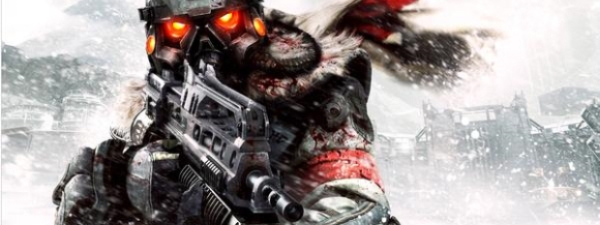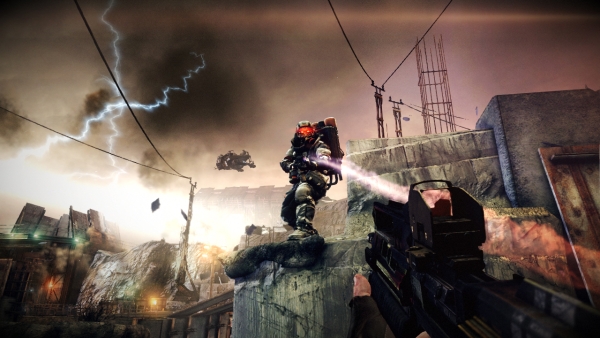
Killzone 2‘s multiplayer confused many casual shooter fans with its weighty movement and gun handling, but offered a treasure trove of depth and strategy for players who wanted a little more from their online experiences. This time around Guerilla Games strove to make the game more accessible to the console demographic while expanding on the strength of the last iteration. Killzone 3‘s multiplayer represents a culmination of compromise and innovation, showing off the characteristic production values and quality that no other developer can really claim.
Platforms: PS3
Publisher: Sony Computer Entertainment America
Developer: Guerrilla Games
Genre: First Person Shooter
Release Date: February 22, 2011
ESRB Rating: Mature
The last game required a lot of effort on the part of the player to really excel. Every weapon had a learning curve and players who discerned how to balance their weapons using the right rate of fire rose to the top of each match’s leaderboard. The aiming this time is much more responsive, and the popular technique of aiming down the sights and shooting until the enemy is killed actually works most of the time. This is reinforced by many weapons now having the holographic sights that mainstream gamers obsess over in their military shooters. This may be disappointing to players who enjoyed a clear advantage over others through their sheer experience alone, but it arguably makes things a little more fun, more “pick up and play” if you will, and it now makes selecting the right tool for the job all the more important. And if there’s one way in which Killzone 3 is an improvement over its predecessor, it’s the variety of weapons and equipment to choose from, as well as the expanded freedom in how to implement them.
These new options define the class system, which was central to Killzone 2’s personality. In Killzone 3, instead of unlocking new classes as you rank up, all of them are selectable at the start, offering a myriad of weapons and abilities to the player right out the gate. Although you still need to unlock primary and secondary weapons in successive order, each class ends up with very different weapons potent in very different situations, so not only does each class play noticeably differently, but players can really develop their own signature style in that class. This offers depth and customization that was regretfully absent in the last game; it simultaneously satiates the superficial needs of casual players who want something new always on the horizon while offering Killzone veterans more options to explore.
The malleability of the class system is also present in the map design and game modes. In Killzone 2, each map had to be amenable to the seven different objective types in Warzone. Now, each map also has to adapt to Guerilla Warfare, the game’s take on Team Deathmatch, and at least three will also have to accommodate Operations, a game of linear, serialized objectives interspersed with cutscenes depicting the best players (with their PSN ID’s over their heads) taking action in definitive moments. The Frozen Dam map in the beta wonderfully executes this idea. Guerilla Warfare takes place on the outer perimeter of the dam, on the inside and outside of the facility and the bridges that connect the different areas. Warzone takes place all around the facility, with a sprawling open area in between each team’s spawn serving as a massive, snow-covered football field for games like Search & Retrieve, where the teams ruthlessly battle for every inch, trying to deliver a propaganda speaker to other team’s base. Finally, Operations has players go through just the facility, proceeding to each objective one at a time. The map has all kinds of hot spots for the different game types, and plenty of strategic positions to exploit in each one of them. Killzone 2’s maps sure proved it, but this beta confirms it: when it comes to balancing and mechanics, no studio in the industry can boast better map design than Guerilla.

The same can probably be said about aesthetics, too. The planet Helghan is an industrial dystopia, and this is brought to life by the engagements throughout the steel complexes, or around the pipeline in the center of the snowfield. While most studios have developers with art design backgrounds churning out their fictional worlds, Guerilla hired engineers to make their vision as detailed and fully realized as possible. Critics of the last game also wanted more color, and this has been addressed with hints of red marking the objects scattered around the level and tints of blue making the level more immersive. The addition of color also illuminates just how strong the graphics engine is. Killzone’s graphics are usually deemed “best on consoles” or “best outside of Crysis,” and studios like Naughty Dog and Sony Santa Monica are going to be hard pressed to top this for their next PS3 titles.
Killzone 3 combines the best production values in gaming with a distinctively cerebral take on game mechanics, and balances them both out with a new sense of accessibility. The audio is somewhat of a mixed bag – the guns don’t have the distinctive sounds they had in the last game, but the propaganda recordings from the speakers in Search & Retrive and Capture & Hold are just as spooky as ever, if not more so. But this hardly diminishes the consistent quality that third party developers simply can’t live up to, and most exclusive developers struggle to match. Killzone 3 in action looks a full console generation ahead of the rest of the first person shooter market, and has the substance that studios on the two-year cycle just don’t get. But most of all, those games can no longer claim to be more fun, as the shorter load times and responsive controls make the game very mainstream-friendly. Expect Killzone 3’s multiplayer to be a hit when the game releases later this month on February 22.







